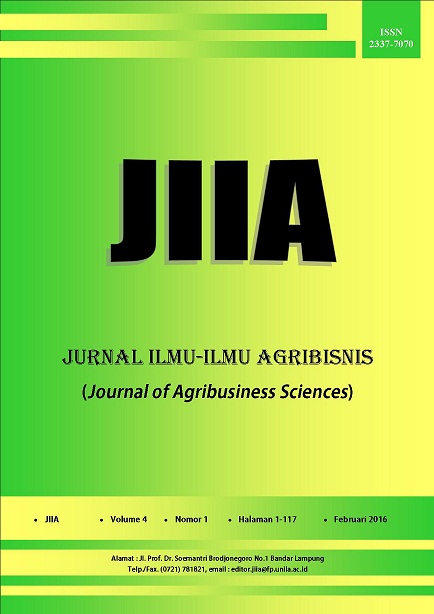GAYA HIDUP RUMAH TANGGA DALAM MENGONSUMSI BUAH-BUAHAN DI BANDAR LAMPUNG
DOI:
https://doi.org/10.23960/jiia.v4i1.1219 Abstract View: 999
Abstract View: 999
Abstract
This research aims to determine the fruit consumption lifestyle and eating pattern of fruits, and the affecting factors on the demand of fruits in the household having primary school age children in Bandar lampung. This research samples are 60 households that have primary school age children. The data is collected in November 2014-April 2015 and analyzed descriptively and statistically by seemingly unrelated regression (SUR). The results of this research showed as follows. The household lifestyle in consuming fruits in side of activity was indicated that 75.0% of the households bought fruits routinely, but 66.7% were rarely consuming fruits in various serving and 73.3% preferred local than import fruits. As much as 98.3% households had opinions that fruits contains a lot of vitamins, minerals and fibers. Banana, papaya, watermelon, snakeskin fruit and avocado were the most consumed fruits in the households in which monthly average consumption was 2-8 times with each weight were 3.8 kg, 2.5 kg, 1.9 kg, 0.9 kg, 0.8 kg. The demand of banana was influenced by the price of banana and total income; of papaya was influenced by the price of papaya, banana and avocado; of watermelon was influenced by the price of watermelon and avocado; of snakeskin fruit was influenced by the price of watermelon and sugar; and of avocado was influenced by the price of avocado.
Key words: demand, eating pattern, fruits, lifestyle
Downloads
Downloads
Published
How to Cite
Issue
Section
License
Authors who publish with this journal agree to the following terms:
Authors retain copyright and grant the journal right of first publication with the work simultaneously licensed under a Creative Commons Attribution License that allows others to share the work with an acknowledgement of the work's authorship and initial publication in this journal.
Authors are able to enter into separate, additional contractual arrangements for the non-exclusive distribution of the journal's published version of the work (e.g., post it to an institutional repository or publish it in a book), with an acknowledgement of its initial publication in this journal.
Authors are permitted and encouraged to post their work online (e.g., in institutional repositories or on their website) prior to and during the submission process, as it can lead to productive exchanges, as well as earlier and greater citation of published work (See The Effect of Open Access).














